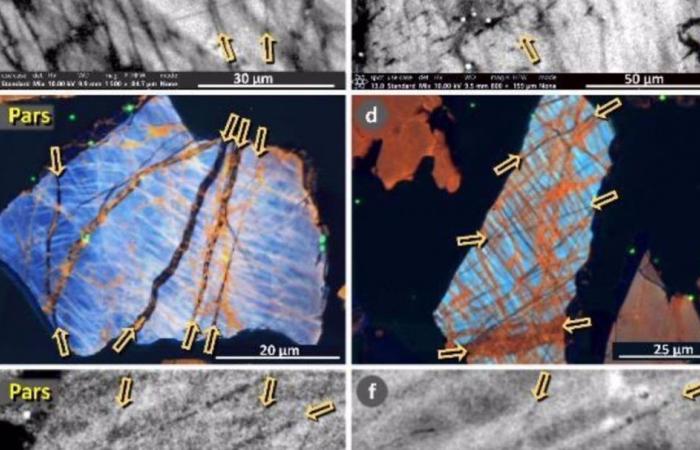Impacted quartz grains, with fissures filled with molten glass. -UCSB
MADRID, June 27 (EUROPA PRESS) –
Quartz samples support the idea that a fragmented comet crashed into the Earth’s atmosphere 12,800 years ago. causing widespread climate change.
Among other things, that event led to the abrupt reversal of the Earth’s warming trend and an anomalous near-glacial period called the Younger Dryas.
UC Santa Barbara Professor Emeritus James Kennett and colleagues report the presence of tracers associated with the cosmic airburst distributed across several separate sites in the eastern United States (New Jersey, Maryland, and South Carolina), materials indicative of the force and temperature involved in such an event, including platinum, microspheres, molten glass, and shock-fractured quartz. The study appears in the journal Airbursts and Cratering from ScienceOpen.
“What we discovered is that the pressures and temperatures were not characteristic of large crater-forming impacts, but rather were consistent with so-called aerial ‘landing’ explosions that do not form many craters“Kennett said it’s a statement.
The Earth is bombarded every day by tons of celestial debris, in the form of tiny dust particles. At the other end of the scale are extremely rare and cataclysmic impacts like the Chicxulub event that 65 million years ago caused the extinction of dinosaurs and other species. Its 150-kilometer-wide impact crater can be found on Mexico’s Yucatan Peninsula.
Somewhere in between are impacts that do not leave craters on the Earth’s surface but are nonetheless destructive. The shock wave of the 1908 Tunguska event felled 2,150 square kilometers of forestwhen the approximately 40-meter-diameter asteroid collided with the atmosphere almost 10 kilometers above the Siberian taiga.
The comet believed to be responsible for the Younger Dryas cooling episode is estimated to have been 100 kilometers wide, much larger than the Tunguska object, and fragmented into thousands of pieces. The layer of sediment associated with the airburst extends across much of the Northern Hemisphere, but can also be found in places south of the equator. This layer contains unusually high levels of rare materials associated with cosmic impacts, such as iridium and platinum, and materials formed under high pressures and temperatures, such as magnetic microspheres (cooled metal droplets), fused glass and nanodiamonds.
Researchers are particularly interested in the presence of shocked quartz, indicated by a pattern of lines, called lamellae, that show stress large enough to deform the crystalline structure of quartz, a very hard material. This “crème de la crème” of cosmic impact evidence is present in impact craters, however, Linking shocked quartz to cosmic air bursts has proven to be more of a challenge.
“In the extreme form, like when an asteroid hits the Earth’s surface, all the fractures are very parallel,” Kennett explained. In the realm of cosmic airbursts, there are different variables present in the realm of cosmic airbursts. “If you think about it, the pressures and temperatures that produce these fractures will vary depending on the density, the angle of entry, the altitude of impact and the size of the impactor.
“What we have discovered – and this is characteristic of the impact layer, called the Younger Dryas Boundary – is that, although we occasionally see examples of ‘traditional’ shocked quartz with parallel fractures in the quartz grains, “mostly we see grains that are not parallel”said.
These fractures are seen in an irregular, web-like pattern of intersecting and meandering lines and surface and subsurface fissures, in contrast to the parallel, planar deformations of impact-associated shocked quartz found in craters. These subparallel and subplanar deformations are largely due to the relatively lower pressures caused by explosions occurring above the ground, the researchers say. unlike impacts that make contact with Earth.


